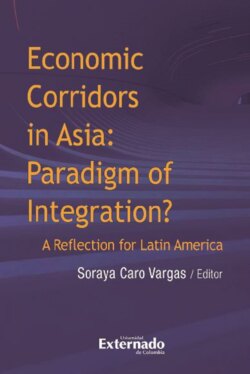Читать книгу Economic corridors in Asia : paradigm of integration? A reflection for Latin America - Varios autores - Страница 16
На сайте Литреса книга снята с продажи.
REFERENCES
ОглавлениеBRAHMAWONG, P. & SUKHAROMANA, R. (2011). East-West Economic Corridor and Southern Economic Corridor of Greater Mekong Subregion: Who Gains and Who Loses? School of Economic and Public Policy. Srinakharinwirot University. Retrieved from: http://econ.swu.ac.th/images%5Cword%5C7.pdf
Brookings Report. (2013). Economic Corridors. Retrieved from: https://www.brookings.edu/research/economic-corridors/
BRUNNER, H.-P. (2013). What is Economic Corridor Development and What can it Achieve, in Asia’s subregions? Retrieved from: https://www.adb.org/sites/default/files/publication/100110/reiwp-117-economic-corridor-development.pdf
CALDERÓN GARCÍA, M. (2019). E. TZILI-APANGO (2018). El camino al siglo del Pacífico. Las otras rutas de la seda del siglo XXI. México: Palabra de Clío. 200 pp.. Estudios de Asia y África, 54(2), 408-411. DOI: http://dx.doi.org/10.24201/eaa.v54i2.2430
CORDEIRO PIRES, M. & PAULINO, L. A. (2017). Reflexiones sobre la hegemonía y la política internacional de China: la iniciativa “Cinturón y Ruta” como una estrategia de desarrollo pacífico. Relaciones Internacionales, 26 (53), 206-228. https://doi.org/10.24215/23142766e019
DIRMOSER, D. (2017). La Gran Marcha china hacia el oeste. Revista Nueva Sociedad (270), 27-38.
DUSSEL, E., ARMONY, A. & SHOUJUN, A. (Coord.). (2018). Building Development for a New Era. México: Asian Studies Center, Center for International Studies.
DYMSKI, G. (2016). Making Financial Instability Visible in Space as Well as Time: Towards a more Keynesian Geography, Research Gate. Retrieved from: 316822818_Making_Financial_Instability_Visible_in_Space_as_Well_as_Time_Towards_a_more_Keynesian_Geography
EASTERLING, K. (23/02/2013). Keller Easterling: Extrastatecraft. [Video archive]. Retrieved from: https://vimeo.com/151362358
ELSHAHAWANY, D., HADDAD, E. & LAHR, M. (2017). Accessibility, transportation cost, and regional growth: a case study for Egypt, Middle East Development Journal, 9 (2), 256-277. DOI: 10.1080/17938120.2017.1366773
HEALEY, P. (2004). The Treatment of Space and Place in the New Strategic Spatial Planning in Europe. International Journal of Urban and Regional Research. 28 (1), 45-67. https://doi.org/10.1111/j.0309-1317.2004.00502.x
HILFERDING, R. (1910). Finance Capital: A Study in the latest phase of capitalist development. El Capital Financiero, Madrid, España: Editorial Tecnos. Colección de Ciencias Sociales, Serie de Economía.
HILLHORST, J.G.M. (1973). Development Axes and the Diffusion of Innovation. Development and Change, 4 (1), 1-16. DOI: 10.1111/j.1467-7660.1973.tb00626.x
HOPE, A. & COX, J. (2015). Development Corridors. Retrieved from http://r4d.dfid.gov.uk/pdf/outputs/EPS/Topic_Guide_Development_Corridors.pdf
KHANA, P. (2017). Conectografía: Mapear el futuro de la civilización mundial. Barcelona: Paidós.
KLEYNHANS, H. A. (2001). A Theoretical Framework for Development Corridors. Universidad de Pretoria.
LARUELLE, M. (2018). China’s belt and road initiative and its impact in central Asia. Washington: Central Asia Program, The George Washington University. Retrieved from: https://centralasiaprogram.org/wp-content/uploads/2017/12/OBOR_Book_.pdf
LEE, J. (1 de mayo de 2019). The end of chimerica: the passing of global economic consensus and the rise of us–china strategic technological competition. The United States Studies Centre at the University of Sydney. Retrieved from: https://www.ussc.edu.au/analysis/the-passing-of-global-economic-consensus-and-the-rise-of-us-china-strategic-technological-competition
MUÑOZ, C. (1998). Cómo elaborar y asesorar una investigación de tesis. México: Prentice Hall.
POTTIER, P. (1963). Axes de communication et development economique, Revue Economique: 58-132.
PRAJ, D. & RESTREPO, J. C. (2017). La geopolítica de la reforma China. Revista Relaciones Internacionales, Estrategia y Seguridad, 12 (1), 51-72. https://doi.org/10.18359/ries.2464
PURBOYO, H., SANTOSO, E. & SAWITRi, D. (2012). The Development of Local Nodes along Transportation Corridors: A Review of Development Axes Theory. Paper presented at The 11th IRSA International Conference Natural Resources, Environment and People’s Welfare in Decentralized Indonesia de IRSA, Banjarmasin, Indonesia.
RICHARDSON, H. W. (1978). Growth Centers, Rural Development and National Urban Policy: A Defense. International Regional Science Review, 3(2), 133–152. https://doi.org/10.1177/016001767800300203
ROCHA, M. (2018). El discurso de China sobre el nuevo modelo de relaciones entre grandes potencias y la relación con Estados Unidos durante los gobiernos de Bush y Obama (2005-2017). Revista Mexicana de Ciencias Políticas y Sociales (233), 193-220. DOI: 10.22201/fcpys.2448492xe.2018.233.58617
TURZI, M. (2017). Latin American silk road: China and the Nicaragua canal. Revista de Relaciones Internacionales, Estrategia y Seguridad, 12(2), 163-178. https://dx.doi.org/10.18359/ries.2308
TZILI-APANGO, E. & PALACIOS-CABRERA, E. (2018). El multilateralismo reactivo en el Asia Central ante China y Rusia. Foro Internacional, 58 (3), 459-492, DOI: 10.24201/fi.58i3.2463
WHEBELL, C. F. J. (1969). Corridors: A Theory Of Urban Systems, Annals of the Association of American Geographers, 59:1, 1-26, DOI: 10.1111/j.1467-8306.1969.tb00655.x.
